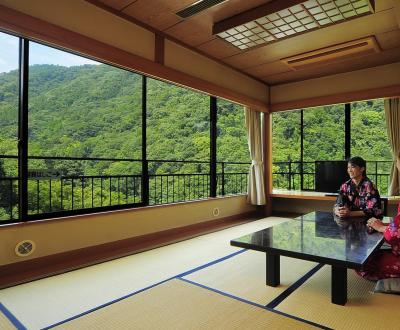Ryokan in Japan: Best Practices and Advices
A lot of travelers in Japan are eager to live a ryokan experience. The Japanese traditional accommodation requires a larger budget than Western-style hotels 🏨, but aside money, some of you might be hindered by the fear of breaching the inn’s rules.
However, it is quite easy to familiarize with the ryokan’s way and we have gathered here instructions to follow and best practices, especially what to do and what not to do, to enjoy you traditional experience to the fullest.
Booking and payments
Usually, and on the contrary to mainstream hotels, it is not possible to pay for the full stay several weeks or months in advance. However, some ryokan now accept full advance payment, but they are among the most frequented by tourists (which does not mean the service quality is lower).
The guest usually pays the bill upon arrival, with cash and in Yens 💴 only. Bank cards 💳 are not always accepted, despite efforts to accommodate foreign visitors. However, it significantly improved over the last years and it is likely to continue in the future.
The room’s price is calculated based on the number of persons per room: it is the price per night multiplied by the number of persons in the group. Do not ask for a degressive rate, nor for a discount. Moreover, it is not usual to tip the staff.
Entrance and shared spaces in the inn
As in any Japanese house, one must take off shoes when entering a ryokan. You will be provided slippers, a pair of indoor shoes to use inside the inn. Note that you might be required to use another pair of slippers when going to the toilets 🚽, especially if the inn has shared lavatories.
Each traditional inn can be considered a kind of guest house, where the staff practices omotenashi (Japanese hospitality). For example, you can let your luggage at the reception if you arrive too early before check-in. As a mark of respect for the place and the other guests, running or shouting in the inn’s precincts are to be avoided.
You can relax in the sento, the common bath – generally non-mixed – before dinner. Do not forget to contact the inn beforehand if you have one or several tattoos, to get instructions on how tattooed guests are handled.
In the room
The rooms are floored with tatami mats. You shall take off your slippers to walk on tatamis and you must not put your luggage on it. The shoji, the sliding panels used as separations between rooms are very fragile: handle them with great care! At dinners’ time, the staff will probably come in your room to set up the futon bedding.
Most of the time, a yukata (a light kimono 👘) is prepared for your arrival, feel free to wear it. You must keep your underwear and close the yukata tightly under the neck: first cover your skin with the right part of the dress, then the left part on top. The belt is worn on the hip for men, and on the waist for women. In winter, you might be provided with a tanzen, a kind of dressing gown to wear above the yukata. At the end of your stay, do not forget to leave yukata and tanzen, as they are the ryokan’s property.
Sometimes dinner and breakfast are included in the price: if so, they will be served directly in the room. Do not forget to inform the inn’s staff beforehand if someone in your group has allergies. Aside meals, you may find teabags and snacks in the room: feel free to enjoy them as they are included in the overall price.


